Institute of Oceanology, Chinese Academy of Sciences
Article Information
- LI Shuang, SUN Saijun, YANG Xiaoyong, SUN Weidong, WU Zhaojian
- Detrital zircon U-Pb age perspective on the sediment provenance and its geological significance of sandstones in the Lamandau region, SW Borneo, Indonesia
- Journal of Oceanology and Limnology, 40(2): 496-514
- http://dx.doi.org/10.1007/s00343-021-0405-6
Article History
- Received Oct. 21, 2020
- accepted in principle Jan. 26, 2021
- accepted for publication Mar. 22, 2021
2 Center of Deep Sea Research, Institute of Oceanology, Center for Ocean Mega-Science, Chinese Academy of Sciences, Qingdao 266071, China;
3 Laboratory for Marine Geology, Pilot National Laboratory for Marine Science and Technology (Qingdao), Qingdao 266237, China;
4 CAS Key Laboratory of Crust-Mantle Materials and Environments, School of Earth and Space Sciences, University of Science and Technology of China, Hefei 230026, China;
5 China Coal Geology Group Limited, Beijing 100040, China
Southeast Asia located at the convergent zone of Eurasian, Pacific, and Indo-Australian plates is tectonically complex. This region comprises numerous fragments of continental crust, volcanic arcs, and small ocean basins (Metcalfe, 2009; Clements et al., 2012; Morley, 2012). Previous studies indicate that the majority of these continental fragments in Southeast Asia (SE Asia) that form the SE Asian core were separated from the Gondwana land. These continental fragments moved northward and then amalgamated with South and North China blocks during the Early Paleozoic to Late Mesozoic. This SE Asian core is referred to as Sundaland (Metcalfe, 1996; Hall, 2009; Hall et al., 2009; Metcalfe, 2011a, b, 2013a, b; Clements et al., 2012). Borneo is the largest island in SE Asia, which lies at the central position of the Sundaland promontory. This island is separated from Indochina, peninsular Malaysia, Sumatra, and Java by the shallow Sundaland shelf in the west and south (Khan, 2018) (Fig. 1). The Southwest Borneo (SW Borneo) block which belongs to the core of Sundaland is the oldest continental fragment of Borneo (Hall, 2009; Metcalfe, 2011a, b; Davies et al., 2014; Khan, 2018). However, the tectonic evolution history of SW Borneo is still in dispute with two conflicting models. One model argues that the SW Borneo block once belonged to the Cathaysia Block due to the development of the Cathaysian flora and fauna fossil in the Carboniferous-Lower Permian limestone at the Sarawak and Kalimantan (Indonesian part of Borneo) borders. This model suggests the SW Borneo block originated from the Gondwana margin, rifted in the Early Permian, then moved northward and already arrived at the Asian margin in the Late Jurassic (Metcalfe, 1996; Hutchison, 2005; Zahirovic et al., 2014). Another alternative model suggested that the SW Borneo block rifted from northwestern Australia since Early Jurassic, moved northward, and was added to Sundaland in the Early Cretaceous. This model was mainly based on the discoveries of similar features of diamond produced in southeastern Kalimantan and northwestern Australia (Taylor et al., 1990; Hall, 2009, 2012; Kueter et al., 2016; White et al., 2016).
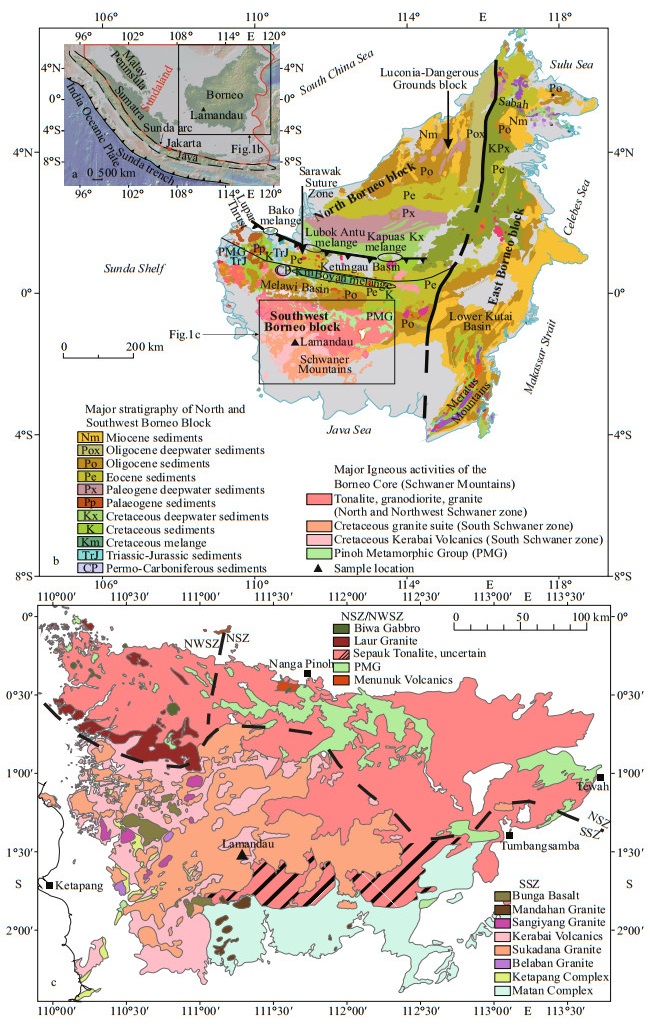
|
| Fig.1 Simplified geological map of Borneo showing the three morphotectonic zones based on rock types and terrain pattern, including the North Borneo block, East Borneo block, and Southwest Borneo block (a & b) (modified after Tate, 2002; Khan, 2018); geological map of the Schwaner Mountains (c) (modified after Breitfeld et al., 2020) Dashed lines indicate approximate boundaries of the NWSZ, NSZ, and SSZ. NSZ: North Schwaner Zoner; NWSZ: Northwest Schwaner Zone; SSZ: South Schwaner Zone. |
The physicochemical stability of zircon makes it difficult to be destroyed by later geological events and thus it could record geological evolution information (Kemp et al., 2008; Sun et al., 2018). Detrital zircon is a common accessory mineral in clastic sedimentary rocks with its age effectively reflecting the tectonic evolution of the basin-orogenic belt (Weltje and von Eynatten, 2004; Zhang et al., 2012; Song et al., 2019). The sedimentary facies and U-(Th)-Pb age distribution of detrital zircons are distinguishable due to the different provenance of sedimentary rocks. Therefore, the depositional time and provenance of sediments can be determined by studying the morphology and age distribution of detrital zircons, then infer the corresponding tectonic evolution history (Zhang et al., 2012; Song et al., 2019). In this study, detrital zircons from sandstones of the Ketapang Complex in SW Borneo were collected and analyzed. The morphology, trace element composition, and age distribution of these zircons can reflect the depositional time, source rock types, provenance, and tectonic evolution history of SW Borneo.
2 GEOLOGICAL SETTING AND SAMPLE DESCRIPTION 2.1 Geological settingAccording to morphotectonic setting features, Borneo Island can be divided into three blocks: North Borneo block, East Borneo block, and SW Borneo block (Tate, 2002; Khan, 2018) (Fig. 1). A large number of Mesozoic-Cenozoic sedimentary rocks and magmatic rocks are present in the North Borneo block. The Sarawak suture zone is located between the North Borneo block and the SW Borneo block. The Sarawak suture zone is bound by the Lupar line to the north where the Bako-Lubok Antu-Kapuas melange zone developed from west to east, and by the Boyan melange zone to the south. Metcalfe (2013a) named this suture zone the Semitau Block, and the oldest dated rocks in this small block are Carboniferous-Early Permian Terbat limestones with warm-water Tethyan faunas. In other recent studies, the Sarawak suture zone was a part of the Kuching zone, which is also bounded by the Lupar Line to the north, but by the Schwaner Mountains to the south (Breitfeld et al., 2017, 2018, 2020; Hennig et al., 2017) (Fig. 1a & b). The East Borneo block includes the Sabah orogenic belt in the north, the Kutai basin in the middle, and the Meratus Mountains in the south (Fig. 1). The Sabah orogenic belt mainly consists of Cretaceous-Miocene metasedimentary rocks and the Meratus Mountains is mainly composed of ophiolite and Jurassic-Miocene metasedimentary rocks (Tate, 2002; Khan, 2018). The SW Borneo block is bounded by the Boyan melange zone to the north and by the Meratus Mountains to the southeast (Fig. 1a & b).
The Schwaner Mountains are located in the SW Borneo block, and these mountains cover an area almost 600 km wide from west to east and more than 200 km from south to north (Hennig et al., 2017; Breitfeld et al., 2020). Large amounts of igneous and metamorphic rocks are developed in the Schwaner Mountains (van Bemmelen, 1939; van Emmichoven, 1939; Setiawan et al., 2013; Davies et al., 2014) (Fig. 1b & c). The igneous rocks in the Schwaner Mountains mainly formed during the Cretaceous with some Jurassic granites developed in the South Schwaner Zone, including Sepauk Tonalite, Sukadana Granite, Kerabai Volcanics, etc. (Davies et al., 2014; Hennig et al., 2017). The metamorphic rocks in the Schwaner Mountains mainly belong to the Pinoh Metamorphic Group (PMG), which are intruded by Cretaceous granites. Recent dating results show these metamorphic rocks contain abundant Cretaceous zircons, and these rocks are inferred to be derived from a volcanogenic protolith that had erupted in the Early Cretaceous and then was subjected to metamorphism associated with granitoid intrusion later in the Early Cretaceous (Davies et al., 2014; Hall, 2017; Breitfeld et al., 2020). In addition, the Ketapang Complex and Matan Complex are also found in the South Schwaner Zone (Breitfeld et al., 2020).
2.2 Sample descriptionThe Ketapang Complex is distributed in the western part of the South Schwaner Zone in SW Borneo, including the Ketapang region of West Kalimantan Province and the Lamandau region of Central Kalimantan Province (De Keyser and Rustandi, 1993; Idrus et al., 2011; Yao et al., 2011b; Breitfeld et al., 2020) (Fig. 1c). The Ketapang Complex is mainly composed of thermally metamorphosed and hydrothermally altered pelitic and psammitic rocks including siltstones, sandstones, shales, calc-silicate rocks, slates, and tuffaceous lithic arenites, with a few carbonate rocks distributing in some regions (Idrus et al., 2011; Breitfeld et al., 2020). The siliceous rocks in this complex show various colors, including light gray, light yellow, or grayish-brown. The formation age of the Ketapang Complex is still in dispute. Previous palynology analysis yielded Albian to Cenomanian ages (De Keyser and Rustandi, 1993; Breitfeld et al., 2020). The thickness of the Ketapang Complex is about 300 meters, with the depositional environment of a shallow sea (Yao et al., 2011b; Harjanto et al., 2019).
The sampling location is near the Ruwai Pb-Zn-Cu-Ag deposit in the Lamandau region, Central Kalimantan Province, and the geographical coordinates are 1°32'00"S, 111°17'30"E (Fig. 2). The Ketapang Complex outcropped in this region is mainly composed of carbonate, pelitic, and psammitic rocks, including limestone, shale, siltstone, and sandstone. The limestones underlie the pelitic and psammitic rocks and are subjected to contact metamorphosed and recrystallized, while the pelitic and psammitic rocks are less altered due to lack of permeability (Idrus et al., 2011; Simbolon et al., 2019). Numerous fresh sandstone samples were collected from the Ketapang Complex in this area. These rocks show a dark reddish surface, fine-grained texture, and massive structure, belonging to fine-grained lithic quartz sandstone (Fig. 3a & b). These sandstones are mainly composed of terrigenous clasts and interstitial materials. The clasts are mainly quartz and a few rock fragments, which are mainly sedimentary (Fig. 3c & d). Quartz and rock fragments in these sandstones show sub-angular to sub-circular with medium separability and are mainly less than 0.25 mm. The interstitial materials are mainly cryptocrystalline quartz and ferruginous cement (Fig. 3c & d).

|
| Fig.2 Geological map of the Ruwai Pb-Zn-Cu-Ag deposit in the Lamandau region, SW Borneo (modified after Idrus et al., 2011) |
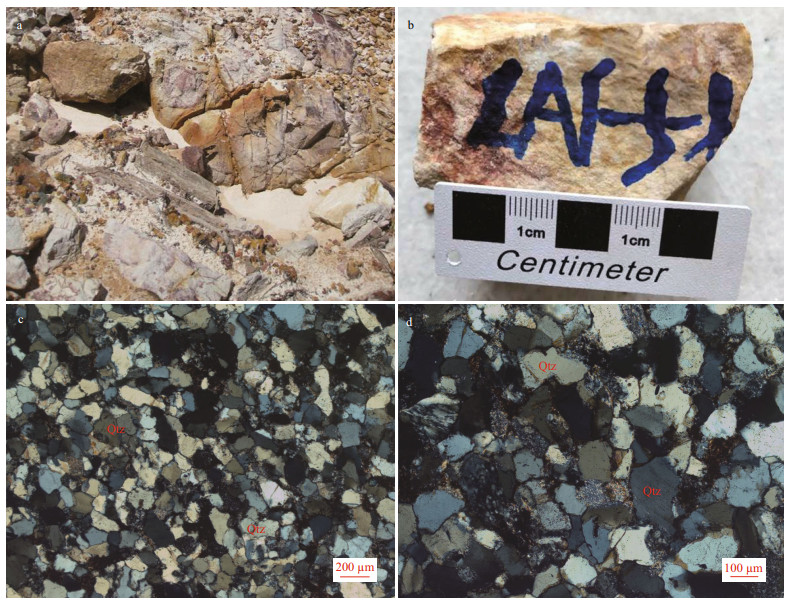
|
| Fig.3 Characteristics of the outcrop, specimen, and microphotograph of sandstones from the Ketapang Complex in the Lamandau region, SW Borneo a. outcrop of sandstones from the Ketapang Complex in the Lamandau region, SW Borneo; b. specimen of sandstones showing dark reddish surface, fine-grained texture, and massive structure; c-d. microphotograph of sandstones. The images were taken with a Zeiss microscope under crossed polars. Qtz: quartz. |
Zircons were separated from the sandstone sample (11LA-1) using magnetic and heavy liquid separation methods and were then purified by handpicking under the binocular microscope. Approximately 120 zircon grains were mounted on an adhesive tape, enclosed in epoxy resin, polished, and then photographed under both transmitted and reflected light (Li et al., 2015). The internal structures of the zircons were examined using the cathodoluminescence (CL) image technique in the Langfang Tuoxuan Rock and Mine Testing Service Co., Ltd., Langfang, China. U-Pb dating and trace element analysis of zircon were simultaneously conducted by laser ablation-inductively coupled plasma-mass spectrometry (LA-ICP-MS) at the Wuhan SampleSolution Analytical Technology Co., Ltd., Wuhan, China. Detailed analytical methods were described by Zong et al. (2010). Laser sampling was performed using a GeolasPro laser ablation system that consists of a COMPexPro 102 ArF excimer laser (wavelength of 193 nm) and a MicroLas optical system, and a "wire" signal smoothing device is included in this laser ablation system (Hu et al., 2015). An Agilent 7700e ICP-MS instrument was used to acquire ion-signal intensities. Helium was applied as a carrier gas. Argon was used as the make-up gas and mixed with the carrier gas via a T-connector before entering the ICP. The spot size of the laser beam was set as ~32 μm. An Excel-based software ICPMSDataCal was used to perform off-line selection and integration of background and analyzed signals, time-drift correction, and quantitative calibration for trace element analysis and U-Pb dating (Liu et al., 2008). Uranium-Pb ages of zircons were calculated by using the ISOPLOT program (Ludwig, 2003).
3.2 Zircon ageThese detrital zircons from sandstones of the Ketapang Complex (11LA-1) show various grain sizes (80-150 μm) and shapes (including long columnar, short columnar, and equigranular) (Fig. 4). Some zircons show a certain degree of roundness, with the characteristic of sedimentary detrital zircons. Zircons with different shapes, particle sizes, and zoning structures were selected for U-Pb dating analysis, thus the analytical results can truly reflect their age distribution. The zircon U-Pb dating data are reported in Supplementary Table S1, with 1σ error for the isotopes and apparent ages. The 113 zircons from sample 11LA-1 show effective dating results, and all the 113 zircons plot near the concordia line on the U-Pb Concordia diagram (Fig. 5a). 206Pb/238U apparent ages were used for zircons younger than 1 000 Ma, and 207Pb/206U ages were employed for zircons older than 1 000 Ma due to generally lead loss (Black et al., 2003; Zhang et al., 2012; Sun et al., 2018). The apparent ages of these detrital zircons range from Paleoarchean to Early Cretaceous (3 298-78 Ma), of which 55 zircons belong to the Cambrian-Cretaceous period, and 58 zircons belong to the Precambrian period (Fig. 5b-d). The age distributions of these detrital zircons show six major age populations: 2 476-2 344 Ma, 2 016-1 831 Ma, 1 296-759 Ma, 455-406 Ma, 262-210 Ma, and 187-78 Ma (Fig. 5b-d).

|
| Fig.4 The CL images of all the detrital zircons from sandstones of the Ketapang Complex in the Lamandau region, SW Borneo Class 1: non-abraded crystals; Class 2: abraded crystals with rounded ends but remaining primary faces; Class 3: profoundly abraded or rounded crystal. The red circles show the laser ablation positions. |
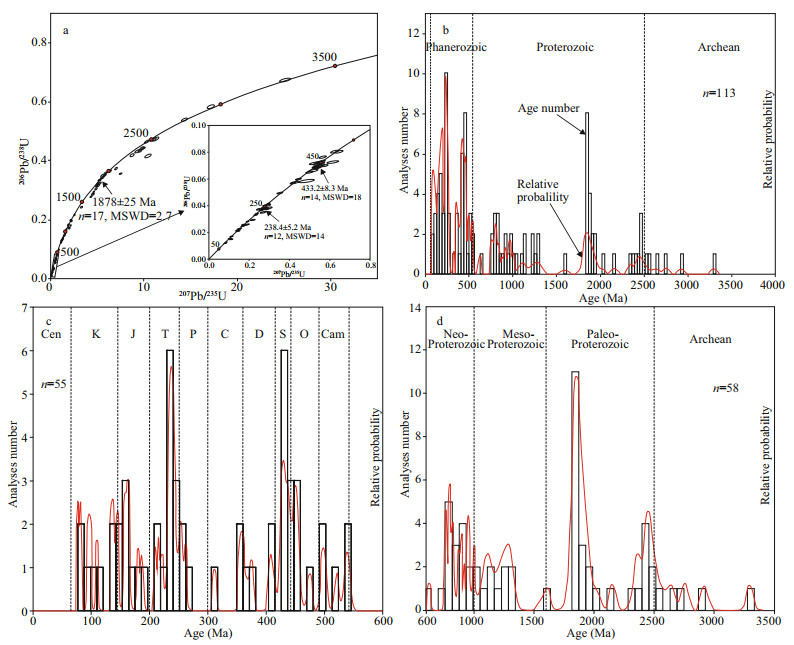
|
| Fig.5 U-Pb Concordia diagram (a) and probability density plot (b, c, d) of LA-ICP-MS detrital zircon U-Pb ages from sandstones of the Ketapang Complex in the Lamandau region, SW Borneo b. probability density plot of all the 113 detrital zircon U-Pb ages of sample 11LA-1; c. probability density plot of 55 detrital zircon U-Pb ages of sample 11LA-1 with ages from 539-78 Ma; d. probability density plot of 58 detrital zircon U-Pb ages of sample 11LA-1 with ages from 3 298-622 Ma. Cen: Cenozoic, K: Cretaceous, J: Jurassic, T: Triassic, P: Permian, C: Carboniferous, D: Devonian, S: Silurian, O: Ordovician, Cam: Cambrian. MSWD: mean squared weighted deviation. |
The 113 detrital zircons from sandstones of the Ketapang Complex have various U and Th contents, ranging from 48.5×10-6 to 3 634×10-6, and from 7.12×10-6 to 1 276×10-6, respectively. The Th/U ratios of five zircons are less than 0.1 (0.02-0.08), and the Th/U ratios of the other 108 zircons range from 0.11 to 3.54 (Supplementary Table S1). According to the CL images (Fig. 4), most zircons show clear oscillatory zones, thus these detrital zircons should have a magmatic origin (Belousova et al., 2002; Wu and Zheng, 2004).
Trace element and rare earth element (REE) compositions of these detrital zircons are reported in Supplementary Table S2. Total rare earth element (ΣREE) contents in these zircons range from 136×10-6 to 2 715×10-6, with the values of light rare earth elements (LREEs) and heavy rare earth elements (HREEs) ranging from (0.92-605)×10-6 and (118-2 476)×10-6, respectively. The chondrite-normalized REE patterns of these zircons show the LREEs depletion relative to the HREEs, with the ratios of LREE/HREE ranging from 0.002 to 1.43 (Fig. 6; Supplementary Table S2). The EuN/EuN* and CeN/CeN* of these zircons range from 0.01 to 0.71 and from 1.15 to 1 228, respectively, showing obviously negative Eu anomalies and strongly positive Ce anomalies (Fig. 6; Supplementary Table S2). These features further indicate these detrital zircons belong to magmatic zircon (Belousova et al., 2002; Zhao et al., 2018).
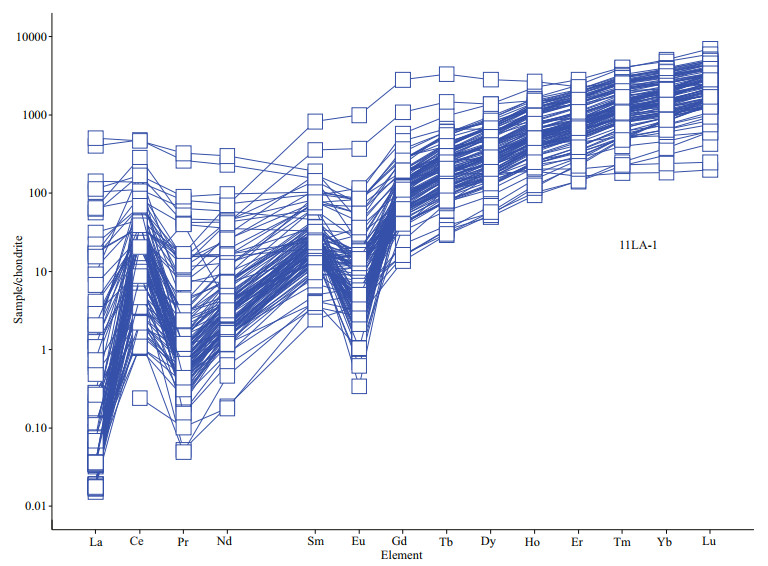
|
| Fig.6 Chondrite-normalized REE distribution patterns of zircons from sandstones of the Ketapang Complex in the Lamandau region, SW Borneo The dada of chondrite are from Sun and McDonough, 1989. |
According to their morphology, these detrital zircons can be divided into three classes: class 1 (non-abraded crystals), class 2 (abraded crystals with rounded ends but remaining primary faces), and class 3 (profoundly abraded or rounded crystals) (Kueter et al., 2016) (Supplementary Table S1). According to the zircon age distribution diagram with classification (Fig. 7), 46 grains belong to class 1, mainly distributed in Mesozoic (25 grains) and Paleozoic (19 grains); 37 grains belong to class 2, dominated in Precambrian (27 grains); and 30 grains belong to class 3, strongly dominated in Precambrian (29 grains). The correlation between abrasion and age shows an age-progressive trend towards strongly abraded zircons (Fig. 7).
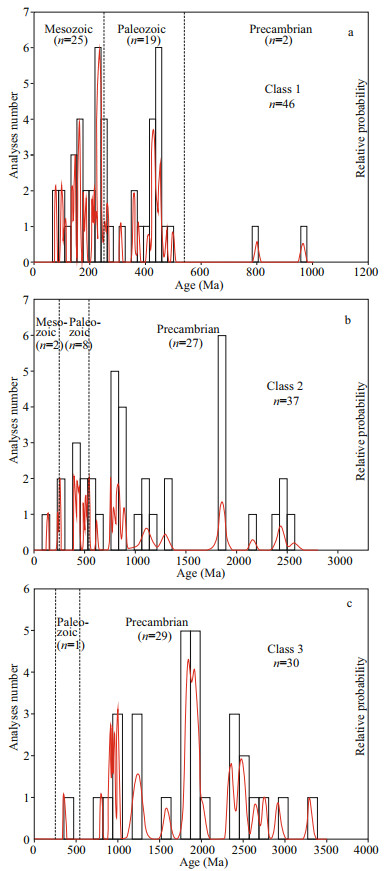
|
| Fig.7 Histograms and probability density plots of detrital zircons with varying degrees of abrasion (after Kueter et al., 2016) Class 1: non-abraded crystals; class 2: abraded crystals with rounded ends but remaining primary faces; class 3: profoundly abraded or rounded crystals. Almost all of the zircons (93%) in the Mesozoic are non-abraded crystals, with few grains (7%) showing moderate abrasion. Most of the zircons (68%) in the Paleozoic belong to nonabraded crystals, and a few grains (28%) show moderate abrasion that have experienced a prolonged alluvial transport. Precambrian zircons are predominantly strongly abraded crystals (97% of class 3), which have experienced extended alluvial transport and multiple erosional cycles. |
The youngest age of detrital zircon in the sediment can represent the maximum depositional age of the strata (Fedo et al., 2003; Kueter et al., 2016). The youngest age of these detrital zircons from sandstones of the Ketapang Complex in SW Borneo is 78 Ma (Supplementary Table S1). Since the youngest detrital zircon U-Pb age may be far older than the depositional age of sedimentary rocks, thus it is inferred that the maximum depositional age of the sandstones is Campanian. However, the depositional age of these sandstones could be younger.
4.2 Source rock typeTrace elements composition in detrital zircons can indicate their source rock types and crystallization environment (Belousova et al., 2002; Grimes et al., 2007). The trace element contents (Y, Hf, U, etc.) and ratios (Yb/Sm, U/Yb, etc.) in zircons change with their source rock types. Grimes et al. (2007) analyzed the trace element compositions of more than 300 zircons from gabbro formed at the Mid-Atlantic and Southwest Indian Ridges, and the results showed that the bivariate diagrams of U/Yb versus Hf or Y could effectively discriminate zircons crystallized in oceanic crust from those of continental crust. All the 113 detrital zircons from sandstones of the Ketapang Complex plot in the continental crust source area, with few zircons plot in the overlapping area between continental crust and oceanic crust, indicating that these detrital zircons were mainly crystallized in a continental crust (Fig. 8a-b). Trace element contents in zircons from ultramafic rocks to granitic rocks tend to increase gradually. The average contents of REEs in kimberlitic zircons are generally less than 50×10-6, while those in carbonatitic and lamproitic zircons increase to (600-700)×10-6. The average contents of REEs in zircons from mafic rocks increase to 2 000×10-6, and those in zircons from granitoids and pegmatites can reach percent levels (Belousova et al., 2002). The total REE contents in these detrital zircons from sandstones of the Ketapang Complex have a wide range from 136×10-6 to 2 715×10-6, indicating that the source rock types of these detrital zircons are complex. The bivariate diagrams of Y versus U or Yb/Sm can effectively discriminate source rock types of zircons (Belousova et al., 2002). The detrital zircons from sandstones of the Ketapang Complex mainly plot in the areas of mafic rocks, lamproites, granitoids, and syenite pegmatites, and a few zircons plot in the overlapping areas between carbonatites and lamproites (Fig. 8c-d), which further indicates that the source rock types of these detrital zircons are relatively abundant.
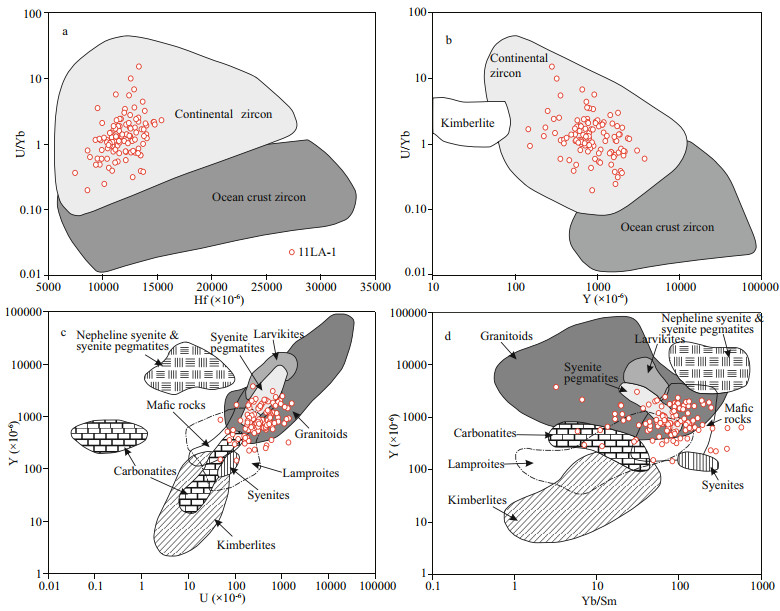
|
| Fig.8 Bivariate diagrams of detrital zircons from sandstones of the Ketapang Complex in the Lamandau region, SW Borneo a. U/Yb vs. Hf diagram: discriminant diagram with continental and ocean crust zircons (after Grimes et al., 2007); b. U/Yb vs. Y diagram: discriminant diagram with continental and ocean crust zircons (after Grimes et al., 2007); c. Y vs. U diagram: discriminant diagram for different source rock types of zircons (after Belousova et al., 2002); d. Y vs. Yb/Sm diagram: discriminant diagram for different source rock types of zircons (after Belousova et al., 2002). |
Zircon age spectra show that the ages of these detrital zircons from sandstones of the Ketapang Complex have a continuous distribution from Early Jurassic to Late Cretaceous (187-78 Ma, 15 zircons), of which 14 zircons belong to class 1 with euhedral and no abraded morphology (Fig. 5, Supplementary Table S1). Thus, it is inferred that these zircons were mainly from the nearby Schwaner Mountains in SW Borneo because large-scale Cretaceous magmatic events occurred in this region (Figs. 1 & 9). The intrusive rocks developed in the South Schwaner Zone are mainly granites and alkali-granites. Petrological and geochemical studies show that these intrusive rocks were formed at ~185 Ma and ~75 Ma in the intraplate tectonic environment with mixed Sand Ⅰ-type characteristics (Davies et al., 2014; Breitfeld et al., 2020). The intrusive rocks developed in the North Schwaner Zone and Northwest Schwaner Zone are mainly granites, tonalites, and granodiorites, and these rocks formed from ~120 Ma to ~80 Ma, with an Ⅰ-type arc magmatic character. The volcanic rocks developed in the North Schwaner Zone formed in the Early Cretaceous, while the volcanic rocks developed in the South Schwaner Zone formed in the Late Cretaceous (Davies et al., 2014; Breitfeld et al., 2020).
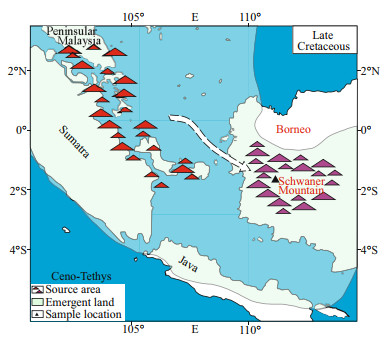
|
| Fig.9 Schematic paleogeographic map of the Sunda Shelf region during the Late Cretaceous (modified after Davies et al., 2014) During the Late Cretaceous, both the Schwaner Mountains and the Permian-Triassic tin-belt granites are interpreted to have supplied material to the sandstones of the Ketapang Complex in the Lamandau region, SW Borneo. The triangles indicate source areas that have been eroded but are not necessarily mountainous. |
The Indochina-East Malaya block and Sibumasu block, separated from the Gondwana in the Paleozoic, belong to Sundaland. These two blocks amalgamated with the South and North China blocks during the Triassic (Hall et al., 2009). The Permian-Triassic granites of the SE Asian Tin Belt were widely developed in the above two blocks, and formed by subduction and post-collision magmatism (Metcalfe, 2009; Sevastjanova et al., 2011). The Tin Belt extending from north to south is distributed in Burma, Thailand, Malay Peninsula, and the Indonesian Tin Islands (Schwartz et al., 1995; Yang et al., 2020). The granites of the Tin Belt can be divided into five parts: (1) the Main Range Granitoid Province (230-184 Ma), distributed in central Thailand, southern Peninsular Thailand, and western Peninsular Malaysia; (2) the Northern Granitoid Province (269-200 Ma), mainly distributed in northern Thailand; (3) the Eastern Granitoid Province (263-79 Ma), extending from eastern Peninsular Malaysia to eastern Thailand; (4) the Western Granitoid Province (149-22 Ma), mainly distributed in northern Peninsular Thailand, western Thailand and Burma; (5) the Granitoids of the Indonesian Tin Islands (251-193 Ma) (Schwartz et al., 1995; Sevastjanova et al., 2011). Ages of 15 detrital zircons in this study belong to PermianTriassic (262-210 Ma), of which 12 zircons (255-222 Ma) yield a weighted mean 206Pb/238U age of 238.4±5.2 Ma (n=12, MSWD=14, 2σ) (Mean Squared Weighted Deviation=MSWD) (Fig. 5a, Supplementary Table S1). Therefore, the relatively nearby Eastern Granitoid Province and the Granitoids of the Indonesian Tin Islands may be one of the sources of these Permian-Triassic detrital zircons (Fig. 9). Triassic and Jurassic meta-igneous rocks were also discovered in the northwestern Schwaner Mountains. Hennig et al. (2017) reported that magmatism and metamorphism in the northwestern Schwaner Mountains occurred at ~238 Ma, 211 Ma, 177 Ma, 162 Ma, and 150 Ma. Setiawan et al. (2013) conducted zircon U-Pb dating of the meta-tonalites in the northwestern Schwaner Mountains of west Kalimantan, and the results showed the magmatic age of these rocks was 233±3 Ma (Late Triassic). Thirteen grains of the Permian-Triassic detrital zircons from sandstones of the Ketapang Complex belong to class 1 with euhedral and no abraded morphology (Fig. 7; Supplementary Table S1). Due to the northwestern Schwaner Mountains are much closer to the Ketapang Complex, these rocks are more likely to be the source of Permian-Triassic detrital zircons from sandstones of the Ketapang Complex (Fig. 9).
4.4 Archean-Carboniferous zircon provenanceThe U-Pb dating results show 83 detrital zircons from sandstones of the Ketapang Complex belong to Archean-Carboniferous. Most of these Archean-Carboniferous zircons belong to class 2 (34 grains, showing abraded with rounded ends but remaining primary faces) and class 3 (30 grains, showing profoundly abraded or rounded crystals) (Fig. 7; Supplementary Table S1). Because the SW Borneo block was derived from the Gondwana, it is inferred that these Archean-Carboniferous zircons should also have the Gondwana origin. However, it is still controversial whether the SW Borneo block once was a part of the Cathaysia Block and separated from the Gondwana land during the Paleozoic or it was located on the northwestern Australian margin before the Jurassic (Metcalfe, 1996, 2009; Zhou et al., 2005; Hall et al., 2009; Hall, 2012; Zahirovic et al., 2014). There are a large number of alluvial diamond deposits in the Borneo, and previous studies have shown that most of these diamonds have Australian origin (Smith et al., 2009; Hall and Sevastjanova, 2012; Kueter et al., 2016; White et al., 2016). But Zahirovic et al. (2014) argue that purely relying on alluvial diamonds to determine the tectonic evolution of SW Borneo is inadequate.
In Southeast Asia, the Indochina-East Malaysia block, the West Burma block, and the West Sumatra block which separated from the Gondwana belong to the core of Sundaland, and these blocks formed a composite Cathaysia Block in the Permian (Sevastjanova et al., 2011, 2016; Metcalfe, 2013a, b). The North Borneo block mainly belongs to the Luconia-Dangerous Grounds continental fragment, which was derived from East Asia that belongs to the Cathaysia Block (Hall, 2012; Khan, 2018). In this study, the age distribution of the detrital zircons from sandstones of the Ketapang Complex was compared with detrital zircons from the Cathaysia, Indochina, East Java, Western Australia, North Borneo block, and the Meratus Mountains in southeastern Borneo (Fig. 10). A certain number of Archean detrital zircons (>2.5 Ga) exist in the sandstones of the Ketapang Complex in SW Borneo, while both of the adjacent Indochina block and North Borneo block which belong to the composite Cathaysia Block barely contain Archean detrital zircons (Bodet and Schärer, 2000; van Hattum et al., 2006; Yu et al., 2008; Wu et al., 2010; Yao et al., 2011a; Xiong et al., 2019) (Fig. 10a-c). In addition, Archean detrital zircons are abundant in East Java and also exist in the sediment from the Meratus Mountains in southeastern Borneo (Smyth et al., 2008; Kueter et al., 2016) (Fig. 10d-e). In this study, the age spectra show that detrital zircons from sandstones of the Ketapang Complex with ages ranging from 1.8 to 1.3 Ga are relatively rare, which is obviously different from those detrital zircons from the Cathaysia Block (Yao et al., 2011a; Hall and Sevastjanova, 2012; Xiong et al., 2019) (Figs. 5 & 10; Supplementary Table S1). Therefore, it is inferred that the SW Borneo block was not added to the composite Cathaysia Block in the Paleozoic, and its tectonic evolution is different from the adjacent Indochina block. Previous studies have found that the areas with Cathaysian flora and fauna fossils developed in Borneo are limited to the Sarawak suture zone (or Kuching zone) and the northwestern Kalimantan Domain near the melanges and deformed ophiolites, which further indicates that the SW Borneo block was not a part of the Cathaysia block and has distinctive tectonic evolution history (Hutchison, 2005; Hall et al., 2009; Metcalfe, 2013a).
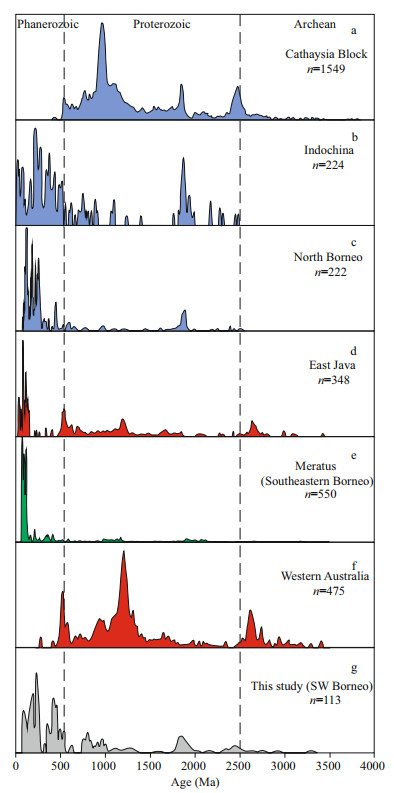
|
| Fig.10 Relative probability diagrams of U-Pb detrital zircon age distributions for comparison among sedimentary samples of Borneo and outboard blocks The outboard blocks include the Cathaysia (a) (Yu et al., 2008; Wu et al., 2010; Yao et al., 2011a; Xiong et al., 2019), Indochina (b) (Bodet and Schärer, 2000), North Borneo block (c) (van Hattum et al., 2006), East Java (d) (Smyth et al., 2008), the Meratus Mountains in southeastern Borneo (e) (Kueter et al., 2016), and Western Australia (f) (Sircombe and Freeman, 1999; Cawood and Nemchin, 2000; Veevers et al., 2005); g. this study. |
The age spectra of Archaean-Carboniferous detrital zircons from sandstones in the Ketapang Complex are similar to those of detrital zircons from East Java, the Meratus Mountains in the southeastern Borneo, and Western Australia, because all of them contain a certain number of Archean zircons and abundant Meso- and Neoproterozoic zircons (1.3-0.7 Ga) (Sircombe and Freeman, 1999; Cawood and Nemchin, 2000; Veevers et al., 2005) (Fig. 10d-g). Therefore, both the SW Borneo block and East Java-West Sulawesi block should have been located on the northwestern margin of Australia during the Paleozoic, and the tectonic evolution of the SW Borneo block and East Java-West Sulawesi block could be related. Thus, the source region of these Archaean-Carboniferous detrital zircons in this study may be the orogenic belts and cratons in northwestern and central Australia (Figs. 11-12). The clastic sediments from these orogenic belts and cratons can be deposited in Canning basins, Kimberley basins, Bonaparte basins, and Amadeus basins in northwestern and central Australia (Haines et al., 2001; Maidment et al., 2007; Lewis and Sircombe, 2013), and then entered into the SW Borneo block and East Java-West Sulawesi block through paleodrainage (Figs. 11-12).
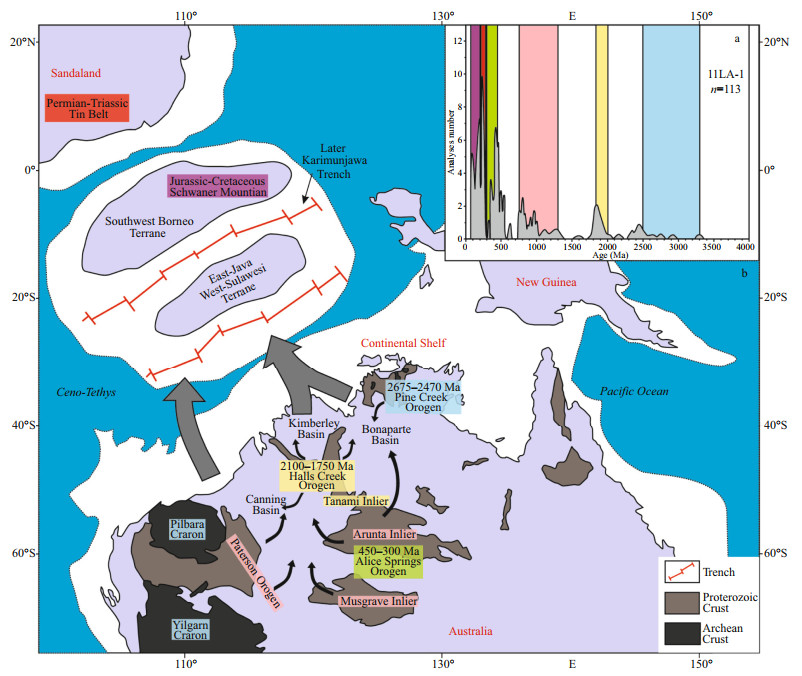
|
| Fig.11 Schematic map of detrital zircon provenances in this study a. the cumulative age density plot of detrital zircons from sandstones of the Ketapang Complex in this study; b. schematic map highlighting potential Archean-Carboniferous zircon provenances in northwestern and central Australia (modified after Kueter et al., 2016). The color-coding of the tectonic provinces corresponds with Fig. 11a. These tectonic provinces supplied sediment materials to the surrounding sedimentary basins (e.g., Canning or Kimberley basin; showing with black arrows). |
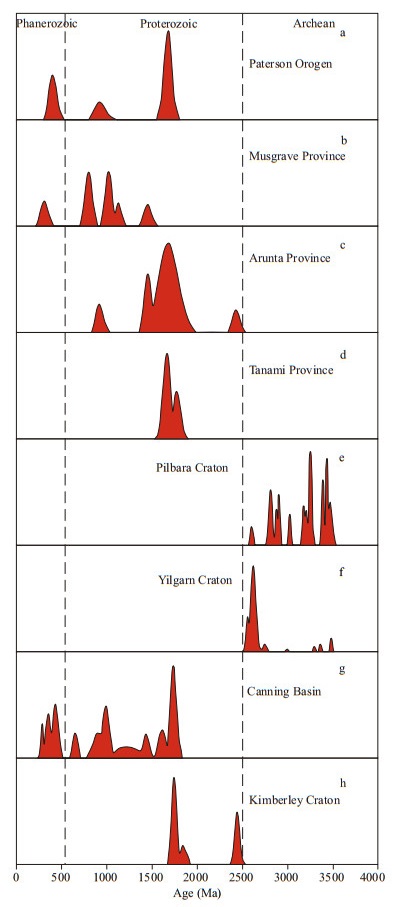
|
| Fig.12 Schematic probability density plots showing zircon populations that are expected to occur in detritus derived from northwestern and central Australia After Pell et al., 1997; Camacho et al., 2002; Cross et al., 2003; Claoué-Long and Hoatson, 2005; Maidment et al., 2007; Neumann and Fraser, 2007; Hall and Sevastjanova, 2012. |
The sandstones of the Ketapang Complex in the SW Borneo Block contain 19 Early Ordovician-Carboniferous detrital zircons (455-311 Ma), of which 14 zircons (455-406 Ma) yield a weighted mean 206Pb/238U age of 433.2±8.3 Ma (n=14, MSWD=18, 2σ) (Fig. 5a, Supplementary Table S1). The Alice Springs intracontinental orogenic belt in central Australia is located in the southern part of the Arunta Province, and its activity time is from 450 to 300 Ma (Haines et al., 2001; Buick et al., 2008) (Fig. 11), therefore this orogenic belt may be the source region of Early Ordovician-Carboniferous detrital zircons in this study.
The sandstones of the Ketapang Complex contain abundant Meso- and Neoproterozoic detrital zircons (25 grains), and their age distribution is mainly between 1 296 and 759 Ma (Fig. 5; Supplementary Table S1). Many Proterozoic-Paleozoic tectonic provinces occurred in northwestern and central Australia, such as the Paterson Orogen, Arunta Inlier, Musgrave Inlier, and Tanami Province (Camacho et al., 2002; Claoué-Long and Hoatson, 2005; Maidment et al., 2007; Hall and Sevastjanova, 2012) (Figs. 11-12). Widespread Grenvillian-age magmatism associated with the assembly of the Rodinia supercontinent was developed in the above tectonic provinces (Neumann and Fraser, 2007) (Fig. 12). Magmatism and tectonism in the Paterson orogen can be divided into three stages, dominated by the Paleoproterozoic ages with a peak at ~1.80-1.76 Ga. Minor Grenvillian-age (~1.2-1.0 Ga) tectonism and relatively restricted felsic magmatism at ~650-630 Ma were also developed in the Paterson orogen (Maidment et al., 2007) (Fig. 12a). The crustal formation and metamorphism of the Arunta Inlier mainly occurred from 2.0 to 1.5 Ga. Minor Grenvillian-age magmatism at ~1 135 Ma occurred in the southern margin of the Arunta Inlier. Detrital zircons from metasedimentary rocks of this Inlier show two obvious age peaks (~1.9-1.8 Ga and ~2.5 Ga) (Claoué-Long and Hoatson, 2005; Maidment et al., 2007) (Fig. 12b). Widespread Grenvillian-age magmatism (~1.20-1.05 Ga) was developed in the Musgrave Inlier and Widespread magmatism at ~1.84-1.80 Ga occurred in the Tanami Province (Camacho et al., 2002; Cross et al., 2003; Maidment et al., 2007) (Fig. 12c-d). The above tectonic provinces in northwestern and central Australia could be the source region of these Meso- and Neoproterozoic detrital zircons from sandstones of the Ketapang Complex in SW Borneo.
The sandstones of the Ketapang Complex contain 25 Paleoproterozoic detrital zircons (2 476-1 831 Ma), of which 17 zircons (2 016-1 831 Ma) have a weighted mean 207Pb/206Pb age of 1 878±25 Ma (n=17, MSWD=2.7, 2σ) (Fig. 5a; Supplementary Table S1). Multi-stage magmatism and tectonism between 1 925 Ma and 1 760 Ma were developed in the Halls Creek Inlier of Kimberley region in northwestern Australia (Pell et al., 1997). The felsic magmatism in the Tanami Province near the Halls Creek Inlier mainly occurred between ~1.84-1.80 Ga (Cross et al., 2003; Maidment et al., 2007). Thus, the above two tectonic provinces in northwestern Australia should be the major source region of Paleoproterozoic detrital zircons from sandstones of the Ketapang Complex in SW Borneo. Meanwhile, the Arunta Inlier may be another possible source region, because the sandstones in this study also contain seven Paleoproterozoic detrital zircons with ages ranging from 2 476 to 2 344 Ma (Fig. 12b; Supplementary Table S1).
The sandstones of the Ketapang Complex contain six Archean detrital zircons (3 298-2 517 Ma) that may have been originated from a region of the Archean craton in the western and northern Australia, including the Pilbara cratons, Yilgarn craton, and the Pine Creek orogen (Fig. 12e-f). Multi-stage magmatism and tectonism developed in the Pilbara Craton range from 3.5 to 2.5 Ga (main population at 3.5-2.9 Ga), while those developed in the Yilgarn craton range from 3.0 to 2.5 Ga (main population at 2.7-2.6 Ga) (Pell et al., 1997; Hall and Sevastjanova, 2012). The Pine Creek orogen forms the northern margin of the North Australian Craton, and the Archean basement of this orogen was formed in 2 675-2 470 Ma (Lyons and Huston, 2006).
4.5 Implication for tectonic evolutionThe analyzed results of these detrital zircons from sandstones of the Ketapang Complex indicate that both the SW Borneo block and East Java-West Sulawesi block were located on the northwestern margin of Australia during the Paleozoic, and the original place of the SW Borneo block may be near the East Java-West Sulawesi block. It is accepted that the East Java-West Sulawesi block (or the Argo block) rifted from the northwestern Australia margin during Jurassic with the opening of Neo-Tethys, then this block moved northward and was added to Sundaland in the Cretaceous (Hall, 2009; Hall et al., 2009; Clements et al., 2012; Zahirovic et al., 2014). This rifting was initiated by the northward slab pull of the Meso-Tethyan seafloor subducting northward beneath the Sundaland core, which led to microcontinent detachment from the northwestern Australian shelf. The seafloor spreading on the northwestern Australian shelf created the Banda Embayment (Müller et al., 2001; Zahirovic et al., 2014). Previous studies suggested the SW Borneo block was located at the place of Banda Embayment (Hall, 2012). The SW Borneo block (or Banda block) could be rifted off from the northwestern margin of Australia in the Early Jurassic because a certain number of Early Jurassic igneous rocks (~185 Ma) occurred in the Schwaner Mountains in SW Borneo, but little Carboniferous-Triassic magmatism occurred in the Schwaner Mountains (Davies et al., 2014; Breitfeld et al., 2020). After leaving the Banda Embayment, the SW Borneo block moved northward together with the East Java-West Sulawesi block and was also added to Sundaland in the Early Cretaceous (Metcalfe, 2011a, b, 2013a; Hall, 2012; Davies et al., 2014) (Fig. 13). The SW Borneo block completely docked with the Sundaland margin by ~110 Ma. The suture between SW Borneo and Sundaland ran south from the Natuna area along the Billiton Depression and was a strikeslip suture (Hall et al., 2009; Hall, 2011, 2012; Morley, 2012). The East Java-West Sulawesi block accreted to the SW Borneo block by ~90 Ma through short-lived south-dipping subduction along with northern West Sulawesi. The Meratus Mountains in southeastern Kalimantan are the suture zone between the East Java-West Sulawesi and SW Borneo blocks (Metcalfe, 2011a, b, 2013a; Hall, 2012; Hall and Sevastjanova, 2012) (Fig. 13). Previous studies that combined rock assemblages features and Bouguer gravity analysis show that the Luconia-Dangerous Grounds continent fragment from East Asia collided with SW Borneo after subduction in the Cretaceous, and this subduction and collision evolved the formation of Sarawak suture zone. The Sarawak suture zone includes fragments of both Asian and SW Borneo origin which may have been mixed and deformed within a wide strike-slip zone (Hall, 2012; Khan, 2018).
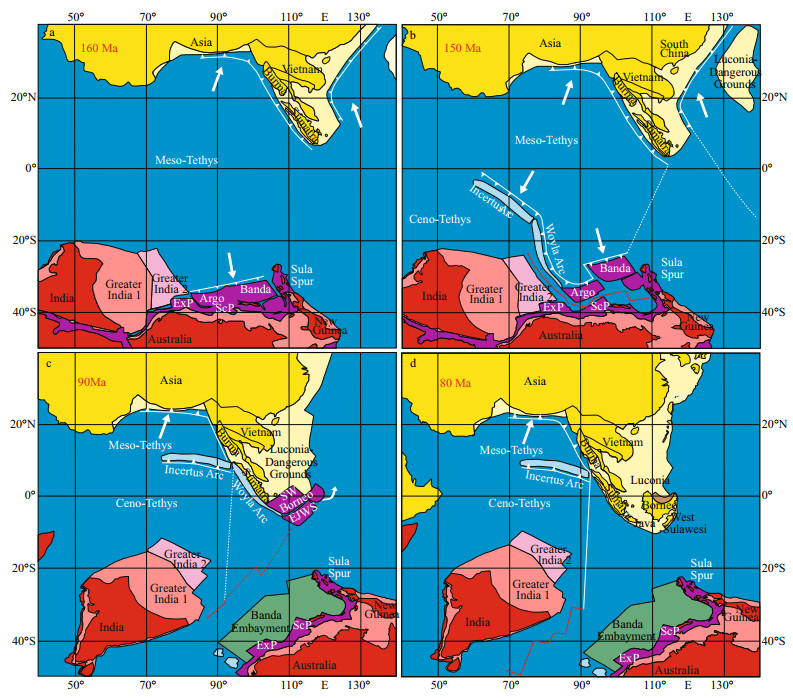
|
| Fig.13 Schematic map of tectonic evolution of SW Borneo (or Banda block) from the Late Jurassic to Late Cretaceous(modified after Hall, 2012) a. at ~160 Ma, SW Borneo (or Banda block) rifted from the northwestern margin of Australia; b. at ~150 Ma, SW Borneo (or Banda block) left Banda Embayment moved northward together with the East Java-West Sulawesi block (or Argo block), with the Neo-Tethys opening through backarc spreading along the northern Gondwana; c. at ~90 Ma, the SW Borneo (or Banda block) and East Java-West Sulawesi block (EJWS) docked at the Sundaland margin, and the boundary between SW Borneo and EJWS was the Meratus and Lok Ulo Sutures. The Luconia-Dangerous Grounds continental fragment docked with the Asian margin and became part of Sundaland; d. at ~80 Ma, the Luconia-Dangerous Grounds continental fragment (presently underlying the Sarawak Basin) accreted to northern Borneo. |
The U-Pb isotopic dating ages of 113 detrital zircons from sandstones of the Ketapang Complex in SW Borneo ranged from 3 298 Ma to 78 Ma, and showed six major age populations: 2 476-2 344 Ma, 2 016-1 831 Ma, 1 296-759 Ma, 455-406 Ma, 262-210 Ma, and 187-78 Ma.
The youngest age of these detrital zircons is 78 Ma, indicating that the maximum depositional age of the sandstones is the Campanian.
Permian-Late Cretaceous detrital zircons were derived from the nearby Schwaner Mountains and the Permian-Triassic tin belt granitoids in SE Asia. Archean-Carboniferous detrital zircons could be derived from the orogenic belts and cratons in northwestern and central Australia.
The provenance of these detrital zircons in this study indicates that the SW Borneo block was located on the northwestern margin of Australia during the Paleozoic. SW Borneo rifted from Australia and moved northward in the Early Jurassic, and this block was added to Sundaland in the Early Cretaceous. The collision after subduction between LuconiaDangerous Grounds continental fragment derived from East Asia and SW Borneo in the Cretaceous induced widespread magmatism in the Schwaner Mountains in SW Borneo.
This study offers important information towards better understanding the tectonic evolution of the SW Borneo block.
6 DATA AVAILABILITY STATEMENTThe data that support the findings of this study are available from the corresponding author upon reasonable request.
7 ACKNOWLEDGMENTWe thank Robert HALL (Department of Earth Sciences, SE Asia Research Group, Royal Holloway University of London, Egham, United Kingdom), the anonymous reviewers, and the editors for their helpful comments and suggestions.
Electronic supplementary materialSupplementary material (Supplementary Tables S1–S2) is available in the online version of this article at https://doi.org/10.1007/s00343-021-0405-6.
Belousova E A, Griffin W L, OoReilly S Y, Fisher N. 2002. Igneous zircon: trace element composition as an indicator of source rock type. Contributions to Mineralogy and Petrology, 143(5): 602-622.
DOI:10.1007/s00410-002-0364-7 |
Black L P, Kamo S L, Williams I S, Mundil R, Davis D W, Korsch R J, Foudoulis C. 2003. The application of SHRIMP to Phanerozoic geochronology; a critical appraisal of four zircon standards. Chemical Geology, 200(1-2): 171-188.
DOI:10.1016/S0009-2541(03)00166-9 |
Bodet F, Schärer U. 2000. Evolution of the SE-Asian continent from U-Pb and Hf isotopes in single grains of zircon and baddeleyite from large rivers. Geochimica et Cosmochimica Acta, 64(12): 2067-2091.
DOI:10.1016/S0016-7037(00)00352-5 |
Breitfeld H T, Davies L, Hall R, Armstrong R, Forster M, Lister G, Thirlwall M, Grassineau N, Hennig-Breitfeld J, van Hattum M W A. 2020. Mesozoic Paleo-Pacific subduction beneath SW Borneo: U-Pb geochronology of the Schwaner granitoids and the Pinoh Metamorphic Group. Frontiers in Earth Science, 8: 568715.
DOI:10.3389/feart.2020.568715 |
Breitfeld H T, Hall R, Galin T, BouDagher-Fadel M K. 2018. Unravelling the stratigraphy and sedimentation history of the uppermost Cretaceous to Eocene sediments of the Kuching Zone in West Sarawak (Malaysia), Borneo. Journal of Asian Earth Sciences, 160: 200-223.
DOI:10.1016/j.jseaes.2018.04.029 |
Breitfeld H T, Hall R, Galin T, Forster M A, BouDagher-Fadel M K. 2017. A Triassic to Cretaceous Sundaland-Pacific subduction margin in West Sarawak, Borneo. Tectonophysics, 694: 35-56.
DOI:10.1016/j.tecto.2016.11.034 |
Buick I S, Storkey A, Williams I S. 2008. Timing relationships between pegmatite emplacement, metamorphism and deformation during the intra-plate Alice Springs Orogeny, central Australia. Journal of Metamorphic Geology, 26(9): 915-936.
DOI:10.1111/j.1525-1314.2008.00794.x |
Camacho A, Hensen B J, Armstrong R. 2002. Isotopic test of a thermally driven intraplate orogenic model, Australia. Geology, 30(10): 887-890.
DOI:10.1130/0091-7613(2002)030<0887:ITOATD>2.0.CO;2 |
Cawood P A, Nemchin A A. 2000. Provenance record of a rift basin: U/Pb ages of detrital zircons from the Perth Basin, Western Australia. Sedimentary Geology, 134(3-4): 209-234.
DOI:10.1016/S0037-0738(00)00044-0 |
Claoué-Long J C, Hoatson D M. 2005. Proterozoic mafic-ultramafic intrusions in the Arunta Region, central Australia: part 2: event chronology and regional correlations. Precambrian Research, 142(3-4): 134-158.
DOI:10.1016/j.precamres.2005.08.006 |
Clements B, Sevastjanova I, Hall R, Belousova E A, Griffin W L, Pearson N. 2012. Detrital zircon U-Pb age and Hf-isotope perspective on sediment provenance and tectonic models in SE Asia. In: Rasbury E T, Hemming S R, Riggs N R eds. Mineralogical and geochemical approaches to Provenance. Geological Society of America Special Paper. p. 37-61.
|
Cross A J, Claoué-Long J C, Crispe A J. 2003. Summary of Results. Joint NTGS-GA geochronology project: Tanami Region 2001-2002. Northern Territory Geological Survey, Record 2003-006, Darwin, Australia. p. 1-35.
|
Davies L, Hall R, Armstrong R. 2014. Cretaceous crust in SW Borneo: Petrological, geochemical and geochronological constraints from the Schwaner mountains. In: The 38th Annual Convention & Exhibition, Proceedings. Indonesian Petroleum Association. p. 1-15.
|
De Keyser F, Rustandi E. 1993. Geology of the Ketapang sheet area, Kalimantan. Map at 1: 250, 000 scale. Bandung, Indonesia: Geological Research and Development Centre.
|
Fedo C M, Sircombe K N, Rainbird R H. 2003. Detrital zircon analysis of the sedimentary record. Reviews in Mineralogy and Geochemistry, 53(1): 277-303.
DOI:10.2113/0530277 |
Grimes C B, John B E, Kelemen P B, Mazdab F K, Wooden J L, Cheadle M J, Hanghøj K, Schwartz J J. 2007. Trace element chemistry of zircons from oceanic crust: a method for distinguishing detrital zircon provenance. Geology, 35(7): 643-646.
DOI:10.1130/G23603A.1 |
Haines P W, Hand M, Sandiford M. 2001. Palaeozoic synorogenic sedimentation in central and northern Australia: a review of distribution and timing with implications for the evolution of intracontinental orogens. Australian Journal of Earth Sciences, 48(6): 911-928.
DOI:10.1046/j.1440-0952.2001.00909.x |
Hall R, Clements B, Smyth H R. 2009. Sundaland: basement character, structure and plate tectonic development. In: Proceedings Indonesian Petroleum Association, 33rd Annual Convention.
|
Hall R, Sevastjanova I. 2012. Australian crust in Indonesia. Australian Journal of Earth Sciences, 59(6): 827-844.
DOI:10.1080/08120099.2012.692335 |
Hall R. 2009. Indonesia, geology. In: Gillespie R, Clague D eds. Encyclopedia of Islands. University of California Press, Berkeley, California, America. p. 454-460.
|
Hall R. 2011. Australia-SE Asia collision: plate tectonics and crustal flow. In: Hall R, Cottam M A, Wilson M E J eds. The SE Asian gateway: history and tectonics of Australia-Asia collision. Geological Society London Special Publication. p. 75-109.
|
Hall R. 2012. Late Jurassic-Cenozoic reconstructions of the Indonesian region and the Indian Ocean. Tectonophysics, 570-571: 1-41.
DOI:10.1016/j.tecto.2012.04.021 |
Hall R. 2017. Southeast Asia: new views of the Geology of the Malay Archipelago. Annual Review of Earth and Planetary Sciences, 45: 331-358.
DOI:10.1146/annurev-earth-063016-020633 |
Harjanto A, Sutarto, Kurniawan P P A. 2019. Geology and the effect of boulder size concretion to bauxite laterite deposit quality at Djanra area, Sandai District, Ketapang Regency, West Kalimantan. Journal Techno, 5(1): 1-14.
|
Hennig J, Breitfeld H T, Hall R, Nugraha A M S. 2017. The Mesozoic tectono-magmatic evolution at the Paleo-Pacific subduction zone in West Borneo. Gondwana Research, 48: 292-310.
DOI:10.1016/j.gr.2017.05.001 |
Hu Z C, Zhang W, Liu Y S, Gao S, Li M, Zong K Q, Chen H H, Hu S H. 2015. pWaveq signal-smoothing and mercury-removing device for laser ablation quadrupole and multiple collector ICPMS analysis: application to lead isotope analysis. Analytical Chemistry, 87(2): 1152-1157.
DOI:10.1021/ac503749k |
Hutchison C S. 2005. Geology of North-West Borneo. Elsevier Science, London. 444p.
|
Idrus A, Setijadji L D, Tamba F, Anggara F. 2011. Geology and characteristics of Pb-Zn-Cu-Ag skarn deposit at Ruwai, Lamandau Regency, Central Kalimantan. Journal of Applied Geology, 3(1): 54-63.
|
Kemp A I S, Hawkesworth C J, Paterson B A, Foster G L, Kinny P D, Whitehouse M J, Maas R, EI MF. 2008. Exploring the plutonic-volcanic link: a zircon U-Pb, Lu-Hf and O isotope study of paired volcanic and granitic units from southeastern Australia. Earth and Environmental Science Transactions of the Royal Society of Edinburgh, 97(4): 337-355.
DOI:10.1017/S0263593300001498 |
Khan A A. 2018. An appraisal of the tectonic evolution of SW Borneo constraints from petrotectonic assemblage and gravity anomaly. Bulletin of the Geological Society of Malaysia, 66: 47-56.
DOI:10.7186/bgsm66201807 |
Kueter N, Soesilo J, Fedortchouk Y, Nestola F, Belluco L, Troch J, Wälle M, Guillong M, Von Quadt A, Driesner T. 2016. Tracing the depositional history of Kalimantan diamonds by zircon provenance and diamond morphology studies. Lithos, 265: 159-176.
DOI:10.1016/j.lithos.2016.05.003 |
Lewis C J, Sircombe K. 2013. Use of U-Pb geochronology to delineate provenance of North West Shelf sediments, Australia. In: Keep M, Moss S J eds. The Sedimentary Basins of Western Australia Ⅳ: Proceedings of the Petroleum Exploration Society of Australia Symposium. Perth, Australia. p. 1-27.
|
Li S, Yang X Y, Sun W D. 2015. The Lamandau IOCG deposit, southwestern Kalimantan Island, Indonesia: evidence for its formation from geochronology, mineralogy, and petrogenesis of igneous host rocks. Ore Geology Reviews, 68: 43-58.
DOI:10.1016/j.oregeorev.2015.01.008 |
Liu Y S, Hu Z C, Gao S, Günther D, Xu J, Gao C G, Chen H H. 2008. In situ analysis of major and trace elements of anhydrous minerals by LA-ICP-MS without applying an internal standard. Chemical Geology, 257(1-2): 34-43.
DOI:10.1016/j.chemgeo.2008.08.004 |
Ludwig K R. 2003. Useros Manual for Isoplot 3.00: a geochronological toolkit for Microsoft Excel. Berkeley: Geochronology Center, 4: 1-70.
|
Lyons P, Huston D L. 2006. Geology and geochronology of the Palaeoproterozoic Pine Creek Orogen. In: Lyons P, Huston D L eds. Evolution and metallogenesis of the North Australian Craton, Conference Abstracts. Geoscience Australia Record 2006/16, Canberra, Australia. p. 53-57.
|
Maidment D W, Williams I S, Hand M. 2007. Testing long-term patterns of basin sedimentation by detrital zircon geochronology, Centralian Superbasin, Australia. Basin Research, 19(3): 355-360.
|
Metcalfe I. 1996. Pre-Cretaceous evolution of SE Asian terranes. In: Hall R, Blundell D eds. Tectonic Evolution of SE Asia. Geological Society, London, p. 97-122.
|
Metcalfe I. 2009. Late Palaeozoic and Mesozoic tectonic and palaeogeographical evolution of SE Asia. In: Hall R, Cottam M A, Wilson M E J eds. Late Palaeozoic and Mesozoic Ecosystems in SE Asia. Geological Society, London. p. 7-23.
|
Metcalfe I. 2011a. Tectonic framework and Phanerozoic evolution of Sundaland. Gondwana Research, 19(1): 3-21.
DOI:10.1016/j.gr.2010.02.016 |
Metcalfe I. 2011b. Palaeozoic-Mesozoic history of SE Asia. In: Hall R, Cottam M A, Wilson M E J eds. The SE Asian Gateway: History and Tectonics of the Australia-Asia Collision. Geological Society, London. p. 7-35.
|
Metcalfe I. 2013a. Gondwana dispersion and Asian accretion: tectonic and palaeogeographic evolution of eastern Tethys. Journal of Asian Earth Sciences, 66: 1-33.
DOI:10.1016/j.jseaes.2012.12.020 |
Metcalfe I. 2013b. Tectonic evolution of the Malay Peninsula. Journal of Asian Earth Sciences, 76: 195-213.
DOI:10.1016/j.jseaes.2012.12.011 |
Morley C K. 2012. Late Cretaceous-Early Palaeogene tectonic development of SE Asia. Earth-Science Reviews, 115(1-2): 37-75.
DOI:10.1016/j.earscirev.2012.08.002 |
Müller R D, Gaina C, Roest W R, Hansen D L. 2001. A recipe for microcontinent formation. Geology, 29(3): 203-206.
DOI:10.1130/0091-7613(2001)029<0203:ARFMF>2.0.CO;2 |
Neumann N L, Fraser G L. 2007. Geochronological synthesis and Time-Space plots for Proterozoic Australia. In: Neumann N L, Fraser G L eds. Geoscience Australia Record 2007/06. Canberra, Australia. 216p.
|
Pell S D, Williams I S, Chivas A R. 1997. The use of protolith zircon-age fingerprints in determining the protosource areas for some Australian dune sands. Sedimentary Geology, 109(3-4): 233-260.
DOI:10.1016/S0037-0738(96)00061-9 |
Schwartz M O, Rajah S S, Askury A K, Putthapiban P, Djaswadi S. 1995. The Southeast Asian tin belt. Earth-Science Reviews, 38(2-4): 95-293.
DOI:10.1016/0012-8252(95)00004-T |
Setiawan N I, Osanai Y, Nakano N, Adachi T, Setiadji L D, Wahyudiono J. 2013. Late Triassic metatonalite from the Schwaner Mountains in West Kalimantan and its contribution to sedimentary provenance in the Sundaland. Berita Sedimentologi, 12(28): 4-12.
|
Sevastjanova I, Clements B, Hall R, Belousova E A, Griffin W L, Pearson N. 2011. Granitic magmatism, basement ages, and provenance indicators in the Malay peninsula: insights from detrital zircon U-Pb and Hf-isotope data. Gondwana Research, 19(4): 1024-1039.
DOI:10.1016/j.gr.2010.10.010 |
Sevastjanova I, Hall R, Rittner M, Paw S M T L, Naing T T, Alderton D H, Comfort G. 2016. Myanmar and Asia united, Australia left behind long ago. Gondwana Research, 32: 24-40.
DOI:10.1016/j.gr.2015.02.001 |
Simbolon D R, Dana C D P, Whitehouse L E. 2019. Metallogenic model of the Ruwai Fe-Zn-Pb-Ag skarn deposit, Central Kalimantan: understanding the complexity from proximal to distal base metal mineralization. In: Proceedings MGEI Unlocking Concealed and Complex Deposits. p. 115-122.
|
Sircombe K N, Freeman M J. 1999. Provenance of detrital zircons on the Western Australia coastline-implications for the geologic history of the Perth basin and denudation of the Yilgarn craton. Geology, 27(10): 879-882.
DOI:10.1130/0091-7613(1999)027<0879:PODZOT>2.3.CO;2 |
Smith C B, Bulanova G P, Kohn S C, Milledge H J, Hall A E, Griffin B J, Pearson D G. 2009. Nature and genesis of Kalimantan diamonds. Lithos, 112(2): 822-832.
|
Smyth H R, Hall R, Nichlos G J. 2008. Early Cenozoic volcanic arc history of East Java, Indonesia: the stratigraphic record of eruptions on a continental margin in a tropical setting. In: Draut A E, Clift P D, Scholl D W eds. Formation and Applications of the Sedimentary Record in Arc Collision Zones. Geological Society of America Special Paper, 436: 199-222.
|
Song Z J, Liu W C, Zhang H Y, Liu C F, Luo K, Wu C. 2019. Detrital zircon geochronology and its geological significance of Upper Permian sandstones in Yushigou area of western Qilian Mountains, China. Geoscience, 33(1): 112-120.
(in Chinese with English abstract) |
Sun S J, Ireland T R, Zhang L P, Zhang R Q, Zhang C C, Sun W D. 2018. Palaeoarchaean materials in the Tibetan Plateau indicated by zircon. International Geology Review, 60(8): 1061-1072.
DOI:10.1080/00206814.2017.1367967 |
Sun S S, McDonough W F. 1989. Chemical and isotopic systematics of oceanic basalts: implications for mantle composition and processes. In: Saunders A D, Norry M J eds. Magmatism in the Ocean Basins. Geological Society Special Publication. p. 313-345.
|
Tate R B. 2002. Geological Map of Borneo. Geological Society of Malaysia: Scale 1: 1, 500, 000, One Sheet.
|
Taylor W R, Jaques A L, Ridd M. 1990. Nitrogen-defect aggregation characteristics of some Australasian diamonds: time-temperature constraints on the source regions of pipe and alluvial diamonds. American Mineralogist, 75: 1290-1310.
|
van Bemmelen R W. 1939. De geologie van het westelijke en Zuidelijk deel van de Westerafdeeling van Borneo. Dienst Mijnbouw Nederlandsch Indië, 68: 187-238.
|
van Emmichoven C P A Z. 1939. De geologie van het centrale en oostelijke deel van de Westerafdeeling van Borneo. Jaarboek Mijnwezen Nederlandsch Oost Indië, Verhandelingen, 68: 7-186.
|
van Hattum M W A, Hall R, Pickard A L, Nichols G J. 2006. Southeast Asian sediments not from Asia: provenance and geochronology of north Borneo sandstones. Geology, 34(7): 589-592.
DOI:10.1130/G21939.1 |
Veevers J J, Saeed A, Belousova E A, Griffin W L. 2005. U-Pb ages and source composition by Hf-isotope and trace-element analysis of detrital zircons in Permian sandstone and modern sand from southwestern Australia and a review of the paleogeographical and denudational history of the Yilgarn Craton. Earth-Science Reviews, 68(3-4): 245-279.
|
Weltje G J, von Eynatten H. 2004. Quantitative provenance analysis of sediments: Review and outlook. Sedimentary Geology, 171(1-4): 1-11.
DOI:10.1016/j.sedgeo.2004.05.007 |
White L T, Graham I, Tanner D, Hall R, Armstrong R A, Yaxley G, Barron L, Spencer L, van Leeuwen T M. 2016. The provenance of Borneoos enigmatic alluvial diamonds: a case study from Cempaka, SE Kalimantan. Gondwana Research, 38: 251-272.
DOI:10.1016/j.gr.2015.12.007 |
Wu L, Jia D, Li H B, Deng F, Li Y Q. 2010. Provenance of detrital zircons from the late Neoproterozoic to Ordovician sandstones of South China: implications for its continental affinity. Geological Magazine, 147(6): 974-980.
DOI:10.1017/S0016756810000725 |
Wu Y B, Zheng Y F. 2004. Genesis of zircon and its constraints on interpretation of U-Pb age. Chinese Science Bulletin, 49(15): 1554-1569.
DOI:10.1007/BF03184122 |
Xiong C, Chen H D, Niu Y L, Chen A Q, Zhang C G, Li F, Xu S L, Yang S. 2019. Provenance, depositional setting, and crustal evolution of the Cathaysia Block, South China: Insights from detrital zircon U-Pb geochronology and geochemistry of clastic rocks. Geological Journal, 54(2): 897-912.
DOI:10.1002/gj.3253 |
Yang J H, Zhou M F, Hu R Z, Zhong H, Williams-Jones A E, Liu L, Zhang X C, Fu Y Z, Mao W. 2020. Granite-related tin metallogenic events and key controlling factors in Peninsular Malaysia, Southeast Asia: new insights from cassiterite U-Pb dating and zircon geochemistry. Economic Geology, 115(3): 581-601.
DOI:10.5382/econgeo.4736 |
Yao J L, Shu L S, Santosh M. 2011a. Detrital zircon U-Pb geochronology, Hf-isotopes and geochemistry-new clues for the Precambrian crustal evolution of Cathaysia Block, South China. Gondwana Research, 20(2-3): 553-567.
DOI:10.1016/j.gr.2011.01.005 |
Yao Z Y, Yang X Z, Zhao M H, Yuan P F. 2011b. Geologic characteristics of the Marau Lead-Zinc ore deposit in Ketapang of Kalimantan Province, Indonesia. Resources Survey & Environment, 32(4): 285-290.
(in Chinese with English abstract) |
Yu J H, OoReilly S Y, Wang L J, Griffin W L, Zhang M, Wang R C, Jiang S Y, Shu L S. 2008. Where was South China in the Rodinia supercontinent?: evidence from U-Pb geochronology and Hf isotopes of detrital zircons. Precambrian Research, 164(1-2): 1-15.
DOI:10.1016/j.precamres.2008.03.002 |
Zahirovic S, Seton M, Müller R D. 2014. The Cretaceous and Cenozoic tectonic evolution of Southeast Asia. Solid Earth, 5(1): 227-273.
DOI:10.5194/se-5-227-2014 |
Zhang J, Li J Y, Liu J F, Li Y F, Qu J F, Feng Q W. 2012. The relationship between the Alxa Block and the North China Plate during the Early Paleozoic: new information from the Middle Ordovician detrial zircon ages in the eastern Alxa Block. Acta Petrologica Sinica, 28(9): 2912-2934.
(in Chinese with English abstract) |
Zhao Y L, Liu Y J, Li W M, Feng Z Q, Wen Q B, Liang C Y. 2018. Detrital zircon LA-ICP-MS U-Pb age of Late Carboniferous to Early Permian sandstones in central Great Xingoan Range and its geological significance. Earth Science, 43(6): 2055-2075.
(in Chinese with English abstract) |
Zhou D, Liu H L, Chen H Z. 2005. Mesozoic-Cenozoic magmatism in southern South China Sea and its surrounding areas and its implications to tectonics. Geotectonica et Metallogenia, 29(3): 354-363.
(in Chinese with English abstract) |
Zong K Q, Liu Y S, Gao C G, Hu Z C, Gao S, Gong H J. 2010. In situ U-Pb dating and trace element analysis of zircons in thin sections of eclogite: refining constraints on the ultra high-pressure metamorphism of the Sulu terrane, China. Chemical Geology, 269(3-4): 237-251.
DOI:10.1016/j.chemgeo.2009.09.021 |
 2022, Vol. 40
2022, Vol. 40


